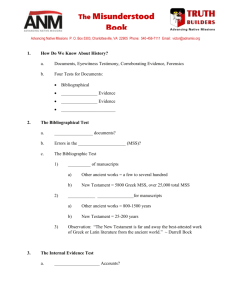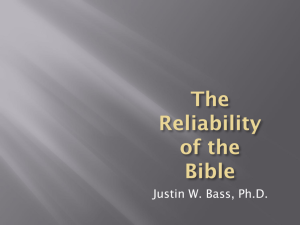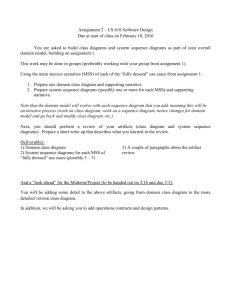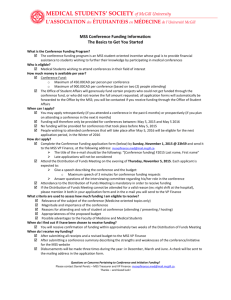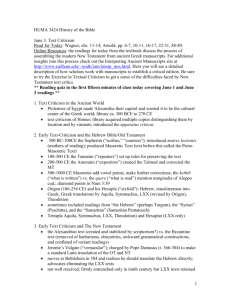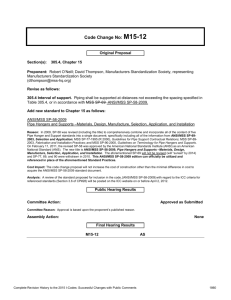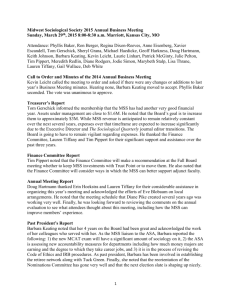Y#U HAVE WON TEN MILLION DOLLARS
advertisement
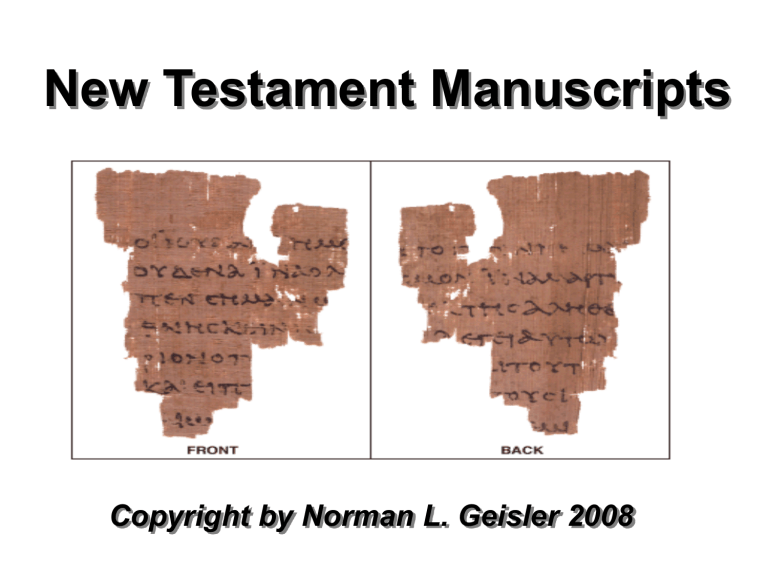
New Testament Manuscripts Copyright by Norman L. Geisler 2008 Outline I. The Names of NT Mss. II. The Number of NT Mss. III. The Nature of NT Mss. Outline I. The Names of NT Mss. 52 John Ryland Fragment (P ) Earliest NT Ms. (A.D. 117-138) John 18:31-33, 37-38 Bodmer Papyri Dated: c. 200 A.D. Housed: Geneva Contents: Luke, John 66 75 (P, P, 1 & 2 Peter & 72 Jude P ) Value: Earliest copy of an Epistle and a Gospel (only 100+ years from the original Gospel. Chester Beatty Papyri Dated: c. 250 A.D. Housed: Dublin Contents: Most of NT Value: Earliest copy of most of the NT Symbols: P, 45P,46P 47 Codex Vaticanus Date: A. D. 325-350 Contents: Most of the OT and most of the NT Value: Has NT and Greek OT (LXX) Housed: Rome Symbol: B Codex Sinaiticus Date: A. D. 340 Contents: Half of OT and almost all of NT Value: One of the oldest and most accurate mss. Housed: Leipzig, Germany Symbol: ( אAleph) Codex Alexandrinus Date: A.D. 450 Contents: Almost all of OT and most of NT (plus some Apocrypha) Housed: British Museum Symbol: A Codex Ephraemi Rescriptus • Codex Ephraemi Rescriptus Contents: Part of OT and most of NT Date: A.D. 345 Housed: Paris Symbol: C Codex Bezae Date: A.D. 450 (or 550) Contents: Most of NT (in Greek and Latin) Housed: Cambridge University Value: Oldest known bilingual ms. of NT Symbol: D Outline I. The Names of NT Mss. II. The Number of NT Mss. Reliability of NT Documents # Manuscript Copies 25 New Testament 5686 500 643 Homer 1400 Demonsthenes 200 1400 Herodotus Plato Tacitus Caesar Time Gap in Years 8 1200 7 1000 20 1000 10 750 Pliny 7 0 1000 2000 3000 4000 5000 6000 Total Number of Manuscripts Greek: 5,700 Latin: 10,000+ Ethiopic 2,000+ Slavic 4,000+ Armenian 2,500+ Others 500+ Total 25,000 mss. Total Number of Early Citations EARLY CITATIONS OF THE NEW TESTAMENT Writer Gospels Justin Martyr 268 Irenaeus Clement Alex. Origen Tertullian Hippolytus Eusebius Grand Totals 1,038 1,017 9,231 3,822 734 3,258 19,368 Acts 10 194 44 349 502 42 211 1,352 Pauline Epistles 43 499 1,127 7,778 2,609 387 1,592 14,035 General Epistles 6 23 207 399 120 27 88 870 Revelation Totals 3 (266 allusions) 65 11 165 205 188 27 664 This includes every verse in the NT except 11! 330 1,819 2,406 17,922 7,258 1,378 5,176 36,289 Outline I. The Names of NT Mss. II. The Number of NT Mss. III. The Nature of NT Mss. III. The Nature of NT Mss. A. Known from Comparative Studies (Psa. 18 cf. 2 Sam. 22) B. Known from Scribal Practices C. Known from Bible Translations D. Known from Textual Criticism The Testimony of the Scrolls There are Earlier NT manuscripts New Testament 35—150+ yr. gap Most Other Books c. 1000 yr. gap John Ryland--117 A.D.--five verses from John 18:31-33; 37-38 Bodmer Papyri--200 A.D.--most of Luke, John, 1&2 Peter &Jude Chester Beaty Papyri--250 A.D.--nearly all the NT books Vaticanus Manuscript--325-50 A.D.--most of OT and NT The Testimony of the Scrolls Noted Ms. Expert: Sir. Frederick Kenyon “The interval between the dates of original composition and the earliest extant evidence becomes so small as to be in fact negligible, and the last foundation for any doubt that the Scriptures have come down substantially as they were written has now been removed. Both the authenticity and the general integrity of the books of the New Testament may be regarded as finally established” (Kenyon, Bible and Archaeology, 288) The Testimony of the Scrolls Sir Frederick Kenyon’s Testimony “The number of mss. of the New Testament, of early translations from it, and of quotations from it in the oldest writers of the Church, is so large that it is practically certain that the true reading of every doubtful passage is preserved in some one or the other of these ancient authorities. This can be said of no other book in the world” (Our Bible and the Ancient Manuscripts, 55). The Number of Variant Readings 1. In 1707 John Mill estimated about 30,000 variants in the known New Testament manuscripts. 2. By 1874, F. H. A. Scrivener counted nearly 50,000 variants. 3. To date there are over 200,000 known variants, and this figure will no doubt increase some in the future as more manuscripts are discovered. 4. But these variants represent only 10,000 places in the New Testament. 5. If one single word is spelled differently in 3,000 different manuscripts, it is counted as 3,000 variants or readings. Percent of Accuracy of the NT Westcott and Hort estimated that only about onesixtieth rise above “trivialities” and can be called “substantial variations.” It is 98.33 percent pure. Ezra Abbott said about 9/20 (95 percent) of the readings are “various” rather than “rival” readings, and about 9/20 (95 percent) of the rest make no appreciable difference in the sense of the passage. Thus the text is 99.75 percent pure. A.T. Robertson said the real concern is with about a “thousandth part of the entire text.” So, the reconstructed text of the New Testament 99.9 percent free from real concern. B.Philip Schaff estimated that of the 150,000 variations known, only 400 affected the sense; and of those only 50 were of real significance; and of these not one affected “an article of faith….” What if you received this message? "Y#U HAVE WON TEN MILLION DOLLARS" Would you collect the money? What if you received this message? ”Y#U HAVE WON TEN MILLION DOLLARS" "YO# HAVE WON TEN MILLION DOLLARS“ Now you are even more sure! If you received this message, you would have no doubt! "Y#U HAVE WON TEN MILLION DOLLARS" "YO# HAVE WON TEN MILLION DOLLARS" "YOU #AVE WON TEN MILLION Note: DOLLARS" • • • Even with mistakes, 100% of the message comes through. The more errors, the more sure you are of the message. The Bible has less copy errors than this. Are These Three Messages Different? 1. YOU HAVE WON TEN MILLION DOLLARS 2. THOU HAST WON 10 MILLION DOLLARS 3. Y’ALL HAVE WON $10,000,000 Note: • • • • Of 27 letters in line 2 only 5 are in the words in line 3 (i.e., 18.5 %), yet the message is identical. They are different in form but not in content. Even with the differences, 100% of the message comes through. Many NT manuscript variations are of this NT Compared with Other Ancient Books 1. The Mahābhārata of India has suffered even more corruption. It is about eight times the size of the Iliad and the Odyssey together, roughly 250,000 lines. Of these, some 26,000 lines have textual corruptions (10 percent). Thus, it is only 90% pure. 2. Homer’s Iliad: Only 40 lines (or about 400 words) of the New Testament are in doubt, whereas 764 lines of the Iliad are questioned. Thus, the Iliad is only 95% pure. 3. The NT has one-half of 1 percent similar variants. That would make it 99.5% pure. (Bruce Metzger, Chapters in the History of NT Textual Criticism). The Testimony of the Scrolls There are Better NT Manuscripts The NT Most Other Books 99.9% accuracy 90-95% accuracy The Marabharata---------90% accuracy Iliad of Homer-------------95% accuracy The New Testament------99.9% accuracy Problem: No Original Mss. Why Did God not Preserve the Original? Possible Answers: 1. It may have been worshiped (cf. 2Kgs. 18:4). 2. It may have been corrupted. A. the custodian would have the power to change it and control God’s Word. B. No one can control 5700 copies all over the world. Conclusion • Only the original text is without any error. • The reconstructed Greek text is without any substantial error. • The major translations are without any doctrinal error. Outline I. The Names of NT Mss. II. The Number of NT Mss. III. The Nature of NT Mss. IV. A Debate on NT Mss. NT Manuscripts in Dead Sea Find? A. Jose O’Callaghan Says Yes. Mark 4:28 Mark 6:48 Mark 6:52,53 Mark 12:17 Acts 27:38 Romans 5:11,12 7Q9 1 Timothy 3:16; 4:1-3 2 Peter 1:15 7Q6.1 7Q15 7Q5 7Q7 7Q6.2 c. A.D. 50 c. A.D. 50 c. A.D. 50 c A.D. 50 c. A.D. 60 c A. D. 50-60 7Q4 c. A.D. 100 7Q10 c. A.D. 60 James 1:23, 24 7Q8 c. .D. 50-70 (From Vanderkam, Dead Sea Scrolls, 312) He used accepted scholarly methods of papyrology and paleography on previously “unidentified” fragments of “biblical texts” from Cave 7 to come to his conclusions. Fragment from Mark 6:52-53? (7Q5) Translated into English Fragment from 1 Tim. 3? (7Q4) Fragment from Mark 4:28? (7Q6) B. Some Reactions to O’Callaghan The New York Times: "If Father O'Callaghan's theory is accepted it would prove that at least one of the gospels--that of St.Mark--was written only a few years after the death of Jesus." UPI: It concluded that "...the people closest to the events--Jesus' original followers--found Mark's report accurate and trustworthy, not myth but true history" (ibid., 137). Time magazine: If true, "they can make a bondfire of 70 tons of indigestible German scholarship" (cited by Estranda, 136). Critics: Some agree and many disagree. Many object to his identification and have tried to find other possibilities like apocryphal 1 Enoch (see Vanderkam, chap. 14) for some fragments (e.g., 4, 8, 12, & 14). Some agree, and even Vanderkam admits that it is “feasible” that they contain NT pieces (ibid., 320). C. Some Conclusions • • • • • • • • • 1. The fragmentary nature of the mss. makes it difficult to be dogmatic about their true identification. 2. Nonetheless, O'Callaghan has offered a plausible, albeit revolutionary, possibility. If true,-a. It shows Mark was written within the life time of the apostles. b. This early date leaves no time for mythological embellishment. c. Mark was one of the earlier Gospels. d. The NT was “published” during the life time of the writers. e. It reveals an early NT canon with books from every major section. f. The ms. of 2 Peter argues for its authenticity. g. The absence of John may indicate a later date (A.D. 8090).
